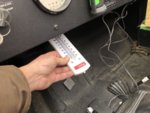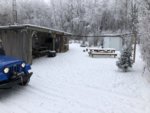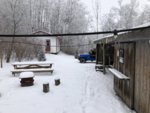great video....any extra to get defrost vents??I have this heater as mentioned in post 55. You won’t be needing to change the fan to an electric unless maybe you plan on driving to Alaska.
You are using an out of date browser. It may not display this or other websites correctly.
You should upgrade or use an alternative browser.
You should upgrade or use an alternative browser.
HVAC heater
- Thread starter HTW
- Start date
B
Bister
Guest
great video....any extra to get defrost vents??
Yep. Everything is listed here. I have the vent kit ordered to. And a snow plow mount plus other stuff.
ROXOR Offroad | Accessories
Darstar
Active member
Did you "T" into the lines or circulate fully through the heater?
I put a tee in the 5/8” hose pressure side by the water pump, then routed into ERG, then to heater inlet. Check out mopar 93 install, I followed his example, I did use silicone heater hose which was easy to work with plus two molded hoses from NAPA.
B
Bister
Guest
I put a tee in the 5/8” hose pressure side by the water pump, then routed into ERG, then to heater inlet. Check out mopar 93 install, I followed his example, I did use silicone heater hose which was easy to work with plus two molded hoses from NAPA.
The factory install goes direct after the ERG and them back to the rad. You'll get more heat if you do that, you get full unrestricted flow. If you watch that video I did you will see me point to where they cut the hoses by the bracket on the valve cover. You can't turn the heat off to the heater in the summer, but a person could change the straight fittings to T's with a couple valves.
EDIT: I looked at his install, where you have the 2nd T, that is where I spliced in direct and it goes straight to the heater, that is my first splice to the heater. Then the return line splices in right across from in on the valve cover. The are just a straight splice, no T's. You will find you can't hold your hand in front of it then. It shows it in the video.
EDIT 2: I show where the splice is done at the 1:40 mark and again at the 4:55 mark.
Last edited by a moderator:
shawnr
Member
Darstar
Active member
The factory install goes direct after the ERG and them back to the rad. You'll get more heat if you do that, you get full unrestricted flow. If you watch that video I did you will see me point to where they cut the hoses by the bracket on the valve cover. You can't turn the heat off to the heater in the summer, but a person could change the straight fittings to T's with a couple valves.
EDIT: I looked at his install, where you have the 2nd T, that is where I spliced in direct and it goes straight to the heater, that is my first splice to the heater. Then the return line splices in right across from in on the valve cover. The are just a straight splice, no T's. You will find you can't hold your hand in front of it then. It shows it in the video.
EDIT 2: I show where the splice is done at the 1:40 mark and again at the 4:55 mark.
Thanks for the info. Leaving for Texas tomorrow, will fixwhen I get there. .......not looking forward to backing it up snowy ramp to a wet trailer floor. I put out 15 50 lb sacks salt today. And 2 more inches tonight..
B
Bister
Guest
Let me know if you notice a difference.Thanks for the info. Leaving for Texas tomorrow, will fixwhen I get there. .......not looking forward to backing it up snowy ramp to a wet trailer floor. I put out 15 50 lb sacks salt today. And 2 more inches tonight..
B
Bister
Guest
Glad to see you received it Shawn! Absolutely, thanks for your business. If anyone would like to checkout installation instructions, they are available on our website! Heater Installation InstructionsGot my heater from on the Rox thank you for the fast shipping install will be in The next few weekends
View attachment 2014
MikeT
Active member
To resurrect this thread with two questions that I have. With the factory heater, why do you cut new holes rather than go through the existing firewall cutouts? I understand the heater has the hoses orientated to the right, but can't you simply turn it 90 degrees?
Secondly, any reason why you couldn't use a two way rocker switch (like with headights) so you can get low/high speeds? perhaps adding a resister to one side of the rocker?
Secondly, any reason why you couldn't use a two way rocker switch (like with headights) so you can get low/high speeds? perhaps adding a resister to one side of the rocker?
Darstar
Active member
I have found the after market heater is a better choice. I have 2 speed fans ,32,000 btu, all mounts under dash just 2 holes in dash for directed ducts....am still working on a defroster outlet, so far it’s an extra duct hose.......
B
Bister
Guest
To resurrect this thread with two questions that I have. With the factory heater, why do you cut new holes rather than go through the existing firewall cutouts? I understand the heater has the hoses orientated to the right, but can't you simply turn it 90 degrees?
Secondly, any reason why you couldn't use a two way rocker switch (like with headights) so you can get low/high speeds? perhaps adding a resister to one side of the rocker?
The hoses are orientated straight back and the heater is right against the fire wall, out of site and the hoses line up perfect with where you have to tie them in. Not worth fighting with moving them, easier to drill the new holes. Those are the only holes you have to drill besides a few for mounting and nice templates are included for drilling them, the defrost kit slips over without cutting your dash or relocating anything and works real good. An hour or 2 tops to install if you have all the tools and the Roxor is prewired for the factory kit. Plug and Play.
I added a 3 speed switch with resistors, made a huge difference. I see universal parts now has a nice 2 speed rocker to match the factory switches with a resistor.
Universal Parts Inc. | High Performance Automotive Cooling | Humboldt, IA
This is how close the heater is to the fire wall. The ends of the pipes coming out of the heater are right at it.
Last edited by a moderator:
- Joined
- Sep 17, 2018
- Messages
- 43
- Points
- 18
- Location
- Lansing, MI, USA
- Roxor Ownership
- Roxor Owner
- Roxor #
- 1440
Earlier in this thread, I posted photos and described how I installed a heater in my Roxor along with how I arranged the heater hoses. The temperatures outside were in the 40's and 50's (Fahrenheit) when I did this and the heater worked very well. But, as winter moved along and temperatures got colder, I found that the heat coming from the heater wasn't hot enough. There was not enough coolant flow through the heater core. I had arranged the heater hoses in a "parallel" type of connection with the egr cooler. I did this because my heater has a shut off valve which allowed me to close off the flow to the heater during the summer. During the winter, the valve could be opened and coolant would flow through the heater core. With the hoses mounted in parallel with the egr cooler, flow through the cooler would still happen if the heater core valve was closed. This winter, I wanted more heat, so I rearranged the heater hoses in series with the egr cooler. But now, I have to make sure I never close the valve on the heater. If I close it, flow will stop through the heater core but also will stop through the egr cooler and that would be a bad thing. The hoses now first flow through the egr cooler which raises the temperature of the coolant a little more. Then it flows through the heater core and then back to the engine. The result is much hotter heat now. I will be comfortable this winter.
Last edited:
B
Bister
Guest
That's how the OEM ones are plumbed. If you add a cross over line before the heater with a valve, you can turn your heater valve off and open the cross over for summer if you like. Mine has coolant flow all year, it doesn't bother me. I actually like it, use it lots on cool evenings in the summer.Earlier in this thread, I posted photos and described how I installed a heater in my Roxor along with how I arranged the heater hoses. The temperatures outside were in the 40's and 50's (Fahrenheit) when I did this and the heater worked very well. But, as winter moved along and temperatures got colder, I found that the heat coming from the heater wasn't hot enough. There was not enough coolant flow through the heater core. I had arranged the heater hoses in a "parallel" type of connection with the egr cooler. I did this because my heater has a shut off valve which allowed me to close off the flow to the heater during the summer. During the winter, the valve could be opened and coolant would flow through the heater core. With the hoses mounted in parallel with the egr cooler, flow through the cooler would still happen if the heater core valve was closed. This winter, I wanted more heat, so I rearranged the heater hoses in series with the egr cooler. But now, I have to make sure I never close the valve on the heater. If I close it, flow will stop through the heater core but also will stop through the egr cooler and that would be a bad thing. The hoses now first flow through the egr cooler which raises the temperature of the coolant a little more. Then it flows through the heater core and then back to the engine. The result is much hotter heat now. I will be comfortable this winter.
Were the EGR coolant lines also 5/8 ID? Looking to install a heater today, and need to know if this is the correct adapter/T coupling size. My heater is 5/8, but I'm unsure of the EGR lines diameter. ThanksNow that I have the cab enclosure installed and with winter coming here in Northern Michigan, a heater makes a nice addition. Here is a brief rundown of how I installed the heater in my Roxor.
View attachment 1564
This photo shows the heater mounted at the center of the dash and about even with the face of the dash. This seemed to be the best location for this particular heater. I used a Maradyne H-410312 heater. It's available on Amazon for about $130 at the time of this writing.
View attachment 1565
For mounting the upper part of the heater, I made some aluminum brackets. These are simple. I used 1/8 x 1 aluminum that I bought at the local hardware store. I cut the length needed and bent it and drilled the holes. The bracket is held to the heater using a #10 sheetmetal screw. It fastens into the slotted hole near the top of the side of the heater. The bracket attaches to the bottom of the dash using #10 machine screws with stop nuts. The dash is too thick to use sheetmetal screws. There is an angle bracket on each side of the heater.
View attachment 1566
The lower part of the heater is attached directly to the floor tunnel. The flanges that are part of the heater case only need a slight twist and bend inward to make them fit right against the floor. For fasteners, I used 1/4 x 1 nuts and bolts.
View attachment 1567
The wiring is routed over to the fuse box under the right side of the dash. I connected the positive wire to fuse F28. This fuse appears to be unused on my Roxor and is a 10 amp fuse. Power to this fuse shuts off with the key which is perfect. There are two factory wires going to this fuse. You want to splice into the wire that is closest to the outer part of the fuse box. For the ground wire, I connected it to an existing ground stud above the fuse box. You will have to add a nut to the stud.
View attachment 1569
In this photo, you can see the two heater hoses coming through the firewall. Heater hoses come in various colors, I chose black so that it looks OK under the hood since the factory hoses are black. Be sure to use a good quality heater hose. Some will kink too bad when making a bend. You also want good quality hoses since these are routed into the interior and a leak could be bad. The hoses are 5/8ths inch inside diameter. I bought 6 feet of hose so I would have enough for the job. I actually ended up using less than 5 feet of the hose.
View attachment 1571
Under the hood, there are a couple of different ways to run the hoses and it all depends on the type of heater you use. Mine has a shut off valve on it. Some heaters do not have a shut off valve. For my heater with the shut off valve, the hoses can only be routed one way, in parallel with the hoses that run to the EGR cooler. For heaters without a shut off valve, the hoses can be run just like I did, or they can be run in series with the EGR cooler hoses. In series means a hose runs from the engine to the EGR cooler, then from the outlet of the cooler to the inlet of the heater, and then from the outlet of the heater back to the engine. In parallel mode like my setup, we have to tap into the two EGR cooler hoses with T-fittings. If we use the "series" mode, closing the valve on the heater will shut off the coolant flow through the EGR cooler and that is not a good thing.
This photo shows how I tapped into the pressure side hose using a T-fitting. I bought the 5/8ths T-fittings at the local NAPA auto parts store.
View attachment 1573
This photo shows how I tapped into the return hose from the EGR cooler. I cut the hose right where it makes a 90 degree bend and added the T-fitting there.
View attachment 1575
Here you can see how the pressure hose to the heater inlet is routed along side the valve cover. It looks good like this.
View attachment 1577
This photo gives a closer look at the firewall where the hoses go through the factory grommets. I cut the center out of the grommets enough so they would slide over the hoses. After cutting them, put them back into the firewall. You'll need to wipe a slight film of lubricant over the hoses so they push through the grommets easily or they'll pop out as you push the hoses through. I lightly wiped WD-40 onto the hoses. It dried later. A little lubricant applied inside the hoses might also make it easier to slide the hoses over the T-fittings.
View attachment 1580
This heater works quite well and will make it fun to run the Roxor around the county this winter. Our county allows side by sides to run on the roads as long as we stay to the right, allow cars to easily pass, and keep it below 25 mph. We can go anywhere as long as we stay off the federal and state roads. We've taken the Roxor just about everywhere we need to go here.
Bister - Any chance you can repost this video? My heater just doesn't cut the mustard, and methinks I have the heater hose supply and return backwards. ThanksI have this heater as mentioned in post 55. You won’t be needing to change the fan to an electric unless maybe you plan on driving to Alaska.
- Joined
- Oct 25, 2020
- Messages
- 246
- Points
- 43
- Location
- Freedomland
- Roxor Ownership
- Roxor Owner
- Roxor #
- 6527
Not likely, that user was banned for some reasonBister - Any chance you can repost this video? My heater just doesn't cut the mustard, and methinks I have the heater hose supply and return backwards. Thanks
LiveFree
New member
This is not about a heater however, I do have a 2024 Roxor for sale with 1500 miles on it. I live in Batesville INDIANA and would sell it for a lot less than a new one. Steven 253-948-6444. Has a few extras addedSo I have not bought a ROXOR yet, but I have been planing my "perfect build" once I get one. Anybody thought about installing a heater in theirs? I live in Michigan and when I get one I feel a heater would be a requirement on those -10 deg days. Thinking about something like the Flex-A-Lite Mojave Heater. If anybody has installed one I would appreciate any info on what worked good and what did not.
View attachment 1329




